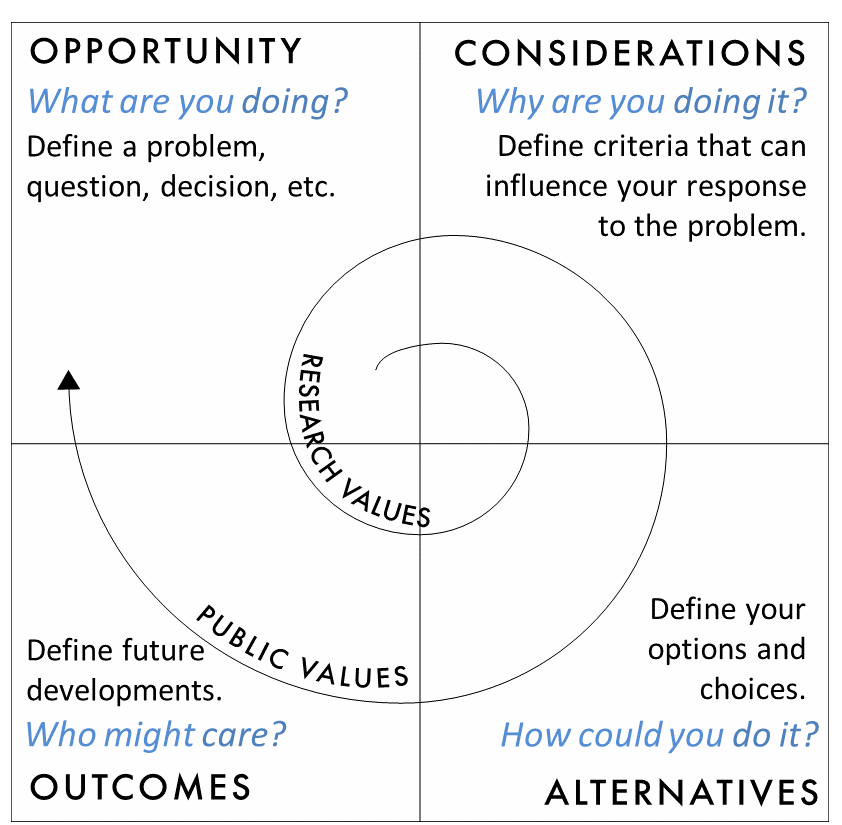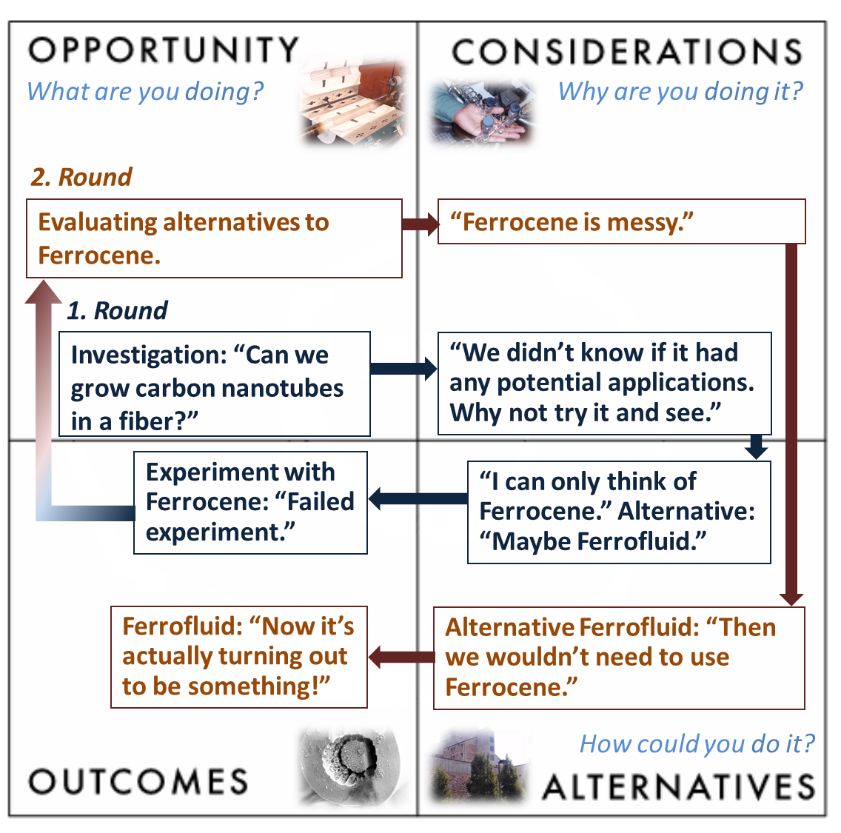Aim
Adjusting research and innovation projects and developmental trajectories in response to societal considerations can help reduce negative outcomes and benefit all stakeholders. While this may seem obvious, scientists and engineers often lack proven and systematic methods to integrate societal considerations into their routine technical activities and processes. Socio-Technical Integration Research (STIR) was developed for this purpose by a social scientist who was working as an “embedded humanist” in an engineering laboratory for three years. Since then, STIR has been successfully applied in dozens of university and industrial laboratories around the world.
The STIR Protocol
In brief, STIR uses a form of collaborative, interdisciplinary dialogue that takes place between an embedded humanist (philosopher, ethicist, etc.) or social scientist (sociologist, political scientist, etc.) and one or more technical practitioners (scientists, engineers, etc.). At the heart of the process is the STIR protocol. The protocol is used to map out opportunities, considerations, alternatives, and potential outcomes. Repeated use of the STIR protocol not only builds dialogue and understanding; over time, the STIR process leads to different “modulations” (changes to the research process and its results) that often enhance the creativity and reflexivity of scientists and engineers.

Data Analysis
If you wish, you may analyze the results that are generated from using the STIR protocol on a regular basis by using the midstream modulation framework (Fisher & Schuurbiers, 2013):
De Facto modulation is the everyday interaction between technical decisions and societal considerations. For instance, a research team may use one disposal or experimental method simply because the laboratory director was trained in one field and not in another. Technical decision-making is what scientists do every day when they decide which experiment they want to carry out, which chemicals, materials, machines or settings they use. In all these cases, societal factors can influence the technical decisions and practices. Identifying the role of societal considerations in technical practices creates a baseline for measuring potential change.
Reflexive modulation occurs when scientists recognize these societal considerations during their everyday activities. When scientists place their activities in a broader perspective they can experience a heightened awareness of the societal dimensions of their technical decisions. We can call these instances of learning.
Deliberate modulation occurs when scientists put any creative insights generated by reflexive modulation to work in research, development, strategic or other forms of technical decision-making. Here, scientists alter or adjust their work, for instance changing practices, processes, or even the goals of their work. This may be done to improve the products or the processes of their work. When they change the way they think or talk, this is called value deliberation and when they change their strategic or material practices, this is called practical adjustments.
Identifying these modulations, and placing them in sequence, can help to show how awareness of societal considerations leads to positive changes in everyday technical work practices. Ultimately, modulation sequences can enhance the public value of science and technology at multiple levels, not only in the laboratory but also in the use of technology in organizations and the dissemination of technology throughout society (Fisher & Rip, 2013).
Practical considerations
Characteristics | Practical considerations |
|---|---|
Suggested time Usually 45 minutes over a period of 12 weeks Level of difficulty Moderate (facilitator skills are needed) Materials needed In-person meetings: STIR protocol sheet, pen and paper for each participant, recorder if permissible, notebook for reflections People involved The facilitator (a social scientist or an outsider not involded in your project, or a member of your project team) Researcher (you), possibly some of your colleagues | Preparation
Implementation
|
Examples
STIR in the Nanotechnology Research Laboratory
The consequences and benefits of nanotechnology are still not fully understood. In 2003, a U.S. Federal statute law required “societal concern…[to be] considered during the development of nanotechnology” (U.S. Congress: Nanotechnology R&D Act of December 2003). This provided an opportunity for researchers to present technical personnel with broader societal considerations and stimulate reflexive modulations. In one STIR study, three graduate researchers worked with three engineering research members of the Department of Mechanical Engineering’s Thermal and Nanotechnology Lab (TNL) (Fisher & Mahajan, 2006). Each pair using the STIR protocol committed to a 12-week period with different levels of interactions. The objective of the study was to see whether STIR could increase awareness, leading to modulations where technical decision-makers were more aware of societal concerns and potential impact. The STIR facilitator measured changes in the reflexive awareness of each participant at the beginning and ending points of the experiment, as well as over time by analyzing the decisions regarding the engineering research activities. The STIR decision protocol was used “to probe the potential flexibility of decision components” (Fisher & Mahajan, 2006).

In the post-study interview, all of the participants demonstrated at least some increased awareness of societal dimensions. Several reflexive and deliberate modulations were documented, including changes to the chemical catalyst used to synthesize carbon nanotubes (Fisher, 2007). For one engineer, the impact of the STIR process and collabortation led not only to instances of reflexive learning but also influenced the direction of the participant’s research. The engineer worked on the synthesis of carbon nanotubes in a silica fiber. During the STIR process, environmental and health risks of the chemical Ferrocene, which is conventionally used in this synthesis, were discussed. As a result, the participant developed a new and unique carbon nanotube disposal method, made a change in the catalyst process (alternative chemicals such as Ferrofluid were used for experiments), and developed safety strategies which did not exist before. The changes led not only to a successful experiment but also resulted in a research paper and focus of a successful dissertation. (Fisher, 2007; Fisher & Mahajan 2006). Here, STIR is shown to alter decisions when societal concerns are explicitly reflected upon over time during technical activities and decision-making processes.
Examples of the STIR protocol in the literature
Other examples are documented in the scholarly literature, for instance by Schuubiers (2011), Flipse et al. (2013, 2014), McTiernan et al. (2016), Lukovics & Fisher (2017), and Flipse & van der Loo (2018). You can also have a look at the STIR Program Website.
Relevant literature
- Fisher, Erik, and Daan Schuurbiers. "Socio-technical integration research: Collaborative inquiry at the midstream of research and development." Early engagement and new technologies: Opening up the laboratory. Springer, Dordrecht, 2013. 97-110.
- Fisher, Erik, and Arie Rip. "Responsible Innovation: Multi‐Level Dynamics and Soft Intervention Practices." Responsible innovation: Managing the responsible emergence of science and innovation in society. 2013. 165-183.
- Fisher, Erik, and Roop L. Mahajan. "Midstream modulation of nanotechnology research in an academic laboratory." Proceedings of ASME International Mechanical Engineering Congress & Exposition (IMECE), Chicago. 2006.
- Fisher, Erik, Roop L. Mahajan, and Carl Mitcham. "Midstream modulation of technology: governance from within." Bulletin of Science, Technology & Society, 26.6 (2006): 485-496.
- Fisher, Erik. "Ethnographic invention: Probing the capacity of laboratory decisions." NanoEthics, 1.2 (2007): 155-165.
- Flipse, Steven M., Maarten CA van der Sanden, and Patricia Osseweijer. "Midstream modulation in biotechnology industry: Redefining what is ‘part of the job’of researchers in industry." Science and engineering ethics 19.3 (2013): 1141-1164.
- Flipse, Steven M., Maarten CA van der Sanden, and Patricia Osseweijer. "Improving industrial R&D practices with social and ethical aspects: Aligning key performance indicators with social and ethical aspects in food technology R&D." Technological Forecasting and Social Change 85 (2014): 185-197.
- Flipse, Steven M., and Chris J. van de Loo. "Responsible innovation during front-end development: increasing intervention capacities for enhancing project management reflections on complexity." Journal of Responsible Innovation5.2 (2018): 225-240.
- Lukovics, Miklós, and Erik Fisher. "Socio-technical integration research in an Eastern European setting: Distinct features, challenges and opportunities." Society and Economy 39.4 (2017): 501-528.
- McTiernan, Kaylie, et al. "Integrating socio-technical research with future visions for tidal energy." 2016 Council of Engineering Systems Universities (CESUN) Symposium. George Washington University. (2016): Jun 27-29.
- Schuurbiers, Daan. "What happens in the lab: Applying midstream modulation to enhance critical reflection in the laboratory." Science and engineering ethics 17.4 (2011): 769-788.
